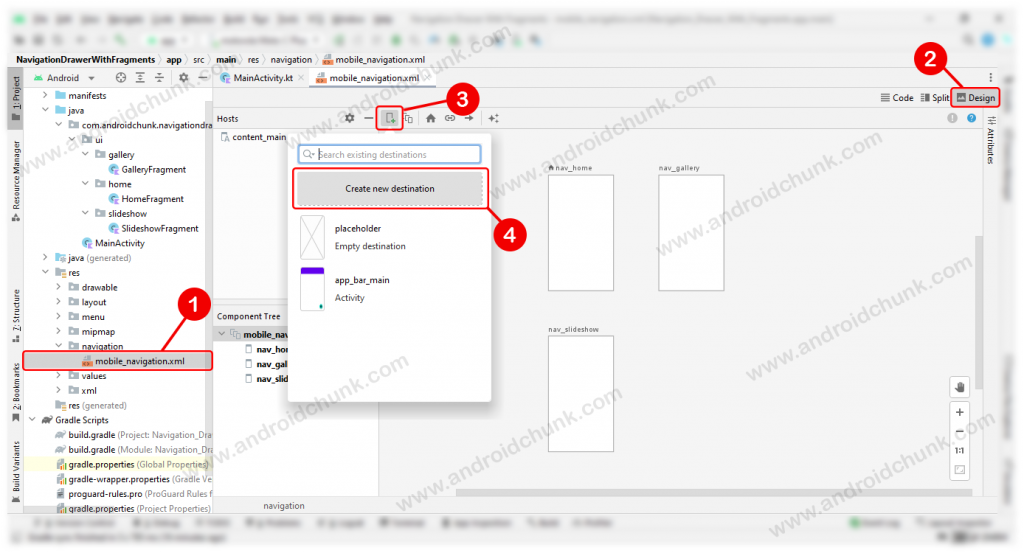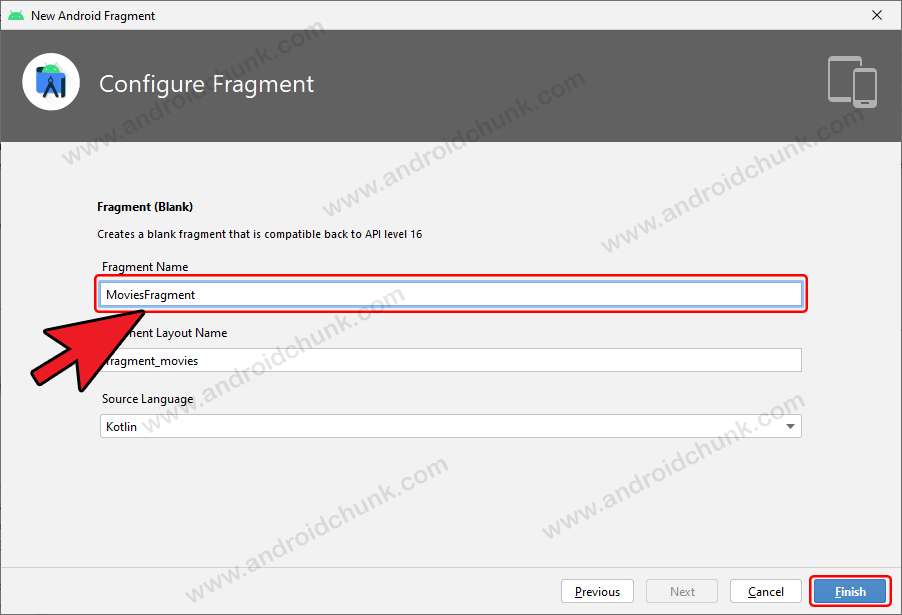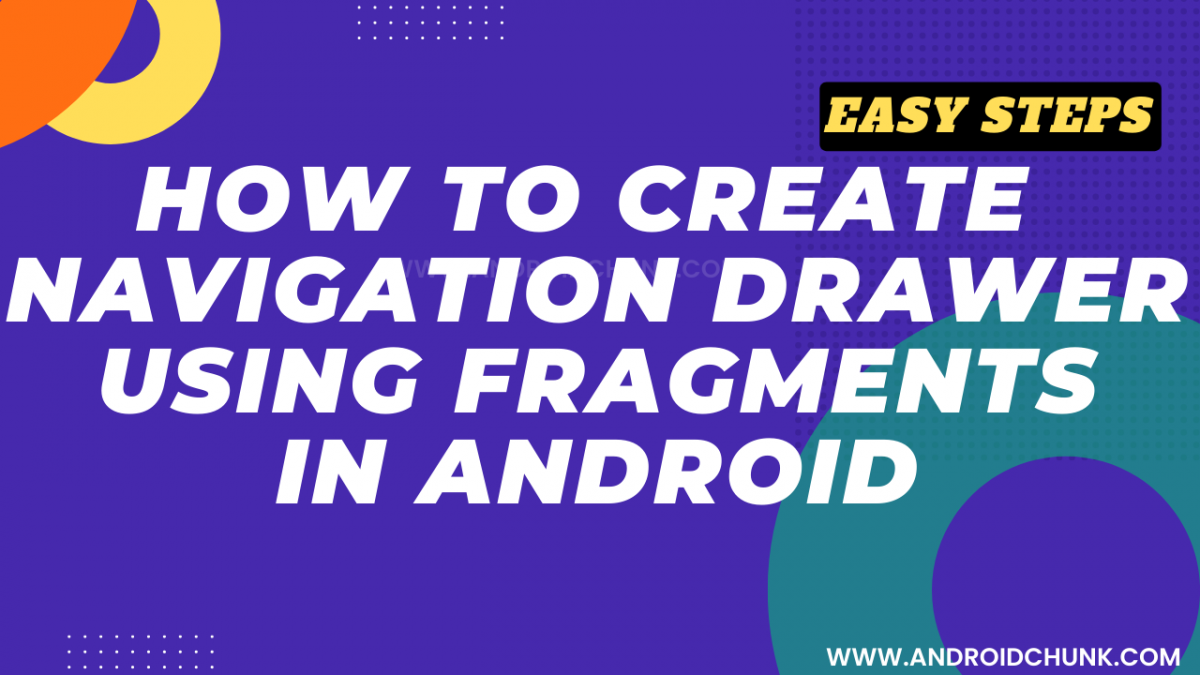2nd April, 2023
Hello Android Developer! Android Navigation Drawer is a UI component that provides a user-friendly interface for accessing different parts of the app. In this part, You will see how to create Android Navigation Drawer Using Fragments.
Step 1: Create New Project
Create a new project in Android Studio from File ⇒ New Project and select Navigation Drawer Activity from the templates.
Step 2: Create Fragment
Open the mobile_navigation.xml file which is available in
app ⇒ src ⇒ main ⇒ res ⇒ navigation directory. Open the design panel and click the New Destination icon in the left top corner. Refer to the image below.

A new popup window will open. I want an empty fragment, so here I select fragment (Blank) option and click the next button.

The next popup window will ask you for details about the new fragment. Fill the required details and click on finish button.

Great! New Fragment has been created successfully. Remove unnecessary variables, methods and verbose from the code.
<?xml version="1.0" encoding="utf-8"?>
<navigation xmlns:android="http://schemas.android.com/apk/res/android"
xmlns:app="http://schemas.android.com/apk/res-auto"
xmlns:tools="http://schemas.android.com/tools"
android:id="@+id/mobile_navigation"
app:startDestination="@+id/nav_home">
<fragment
android:id="@+id/nav_home"
android:name="com.androidchunk.navigationdrawerwithfragments.ui.home.HomeFragment"
android:label="@string/menu_home"
tools:layout="@layout/fragment_home" />
<fragment
android:id="@+id/nav_gallery"
android:name="com.androidchunk.navigationdrawerwithfragments.ui.gallery.GalleryFragment"
android:label="@string/menu_gallery"
tools:layout="@layout/fragment_gallery" />
<fragment
android:id="@+id/nav_slideshow"
android:name="com.androidchunk.navigationdrawerwithfragments.ui.slideshow.SlideshowFragment"
android:label="@string/menu_slideshow"
tools:layout="@layout/fragment_slideshow" />
<fragment
android:id="@+id/nav_movies"
android:name="com.androidchunk.navigationdrawerwithfragments.ui.movies.MoviesFragment"
android:label="@string/menu_movies"
tools:layout="@layout/fragment_movies" />
</navigation>
package com.androidchunk.navigationdrawerwithfragments.ui.movies
import android.os.Bundle
import android.view.LayoutInflater
import android.view.View
import android.view.ViewGroup
import androidx.fragment.app.Fragment
import com.androidchunk.navigationdrawerwithfragments.databinding.FragmentMoviesBinding
class MoviesFragment : Fragment() {
private var _binding: FragmentMoviesBinding? = null
private val binding get() = _binding!!
override fun onCreateView(
inflater: LayoutInflater,
container: ViewGroup?,
savedInstanceState: Bundle?
): View {
_binding = FragmentMoviesBinding.inflate(inflater, container, false)
binding.textMovies.text = "This is movies Fragment"
return binding.root
}
override fun onDestroyView() {
super.onDestroyView()
_binding = null
}
}
package com.androidchunk.navigationdrawerwithfragments.ui.movies;
import android.os.Bundle;
import android.view.LayoutInflater;
import android.view.View;
import android.view.ViewGroup;
import androidx.annotation.NonNull;
import androidx.annotation.Nullable;
import androidx.fragment.app.Fragment;
import com.androidchunk.navigationdrawerwithfragments.databinding.FragmentMoviesBinding;
class MoviesFragment extends Fragment {
private FragmentMoviesBinding binding;
@Nullable
@Override
public View onCreateView(@NonNull LayoutInflater inflater, @Nullable ViewGroup container, @Nullable Bundle savedInstanceState) {
binding = FragmentMoviesBinding.inflate(inflater, container, false);
binding.textMovies.setText("This is movies Fragment");
return binding.getRoot();
}
@Override
public void onDestroyView() {
super.onDestroyView();
binding = null;
}
}
<?xml version="1.0" encoding="utf-8"?>
<RelativeLayout xmlns:android="http://schemas.android.com/apk/res/android"
xmlns:tools="http://schemas.android.com/tools"
android:layout_width="match_parent"
android:layout_height="match_parent"
tools:context=".ui.movies.MoviesFragment">
<TextView
android:id="@+id/text_movies"
android:layout_width="match_parent"
android:layout_height="wrap_content"
android:layout_centerInParent="true"
android:textAlignment="center"
android:textSize="20sp" />
</RelativeLayout>
Step 4: Set Fragment in Navigation Drawer
After creating the fragment you need to add your fragment to the navigation drawer so that the user can access the fragment by selecting the navigation menu item.
Step 4.1: Add Menu Item
Open the menu file of the navigation drawer and add a menu item. This is menu file of navigation drawer. You can add or remove menu from here as per your project requirement. I have used four menu in this project.
Create/Add an icon and set it as the value of the android:icon attribute that is associated with the item.
<?xml version="1.0" encoding="utf-8"?>
<menu xmlns:android="http://schemas.android.com/apk/res/android"
xmlns:tools="http://schemas.android.com/tools"
tools:showIn="navigation_view">
<group android:checkableBehavior="single">
<item
android:id="@+id/nav_home"
android:icon="@drawable/ic_menu_camera"
android:title="@string/menu_home" />
<item
android:id="@+id/nav_gallery"
android:icon="@drawable/ic_menu_gallery"
android:title="@string/menu_gallery" />
<item
android:id="@+id/nav_slideshow"
android:icon="@drawable/ic_menu_slideshow"
android:title="@string/menu_slideshow" />
<item
android:id="@+id/nav_movies"
android:icon="@drawable/ic_menu_movies"
android:title="@string/menu_movies" />
</group>
</menu>
Step 4.2: Modify MainActivity
Open MainActivity and add id (R.id.nav_movies) to the set of AppBarConfiguration.
package com.androidchunk.navigationdrawerwithfragments
import android.os.Bundle
import android.view.Menu
import com.google.android.material.snackbar.Snackbar
import com.google.android.material.navigation.NavigationView
import androidx.navigation.findNavController
import androidx.navigation.ui.AppBarConfiguration
import androidx.navigation.ui.navigateUp
import androidx.navigation.ui.setupActionBarWithNavController
import androidx.navigation.ui.setupWithNavController
import androidx.drawerlayout.widget.DrawerLayout
import androidx.appcompat.app.AppCompatActivity
import androidx.navigation.fragment.NavHostFragment
import com.androidchunk.navigationdrawerwithfragments.databinding.ActivityMainBinding
class MainActivity : AppCompatActivity() {
//appbar-configuration object
private lateinit var appBarConfiguration: AppBarConfiguration
private lateinit var binding: ActivityMainBinding
override fun onCreate(savedInstanceState: Bundle?) {
super.onCreate(savedInstanceState)
//viewBinding
binding = ActivityMainBinding.inflate(layoutInflater)
setContentView(binding.root)
//set actionbar
setSupportActionBar(binding.appBarMain.toolbar)
//fab button click event handling
binding.appBarMain.fab.setOnClickListener { view ->
Snackbar.make(view, "Replace with your own action", Snackbar.LENGTH_LONG)
.setAction("Action", null).show()
}
val drawerLayout: DrawerLayout = binding.drawerLayout
val navView: NavigationView = binding.navView
// Passing each menu ID as a set of Ids because each
// menu should be considered as top level destinations.
appBarConfiguration = AppBarConfiguration(
setOf(
R.id.nav_home, R.id.nav_gallery, R.id.nav_slideshow, R.id.nav_movies
), drawerLayout
)
val navHostFragment = supportFragmentManager.findFragmentById(R.id.nav_host_fragment_content_main) as NavHostFragment
val navController = navHostFragment.navController
setupActionBarWithNavController(navController, appBarConfiguration)
navView.setupWithNavController(navController)
}
override fun onCreateOptionsMenu(menu: Menu): Boolean {
// Inflate the menu; this adds items to the action bar if it is present.
menuInflater.inflate(R.menu.main, menu)
return true
}
override fun onSupportNavigateUp(): Boolean {
val navController = findNavController(R.id.nav_host_fragment_content_main)
return navController.navigateUp(appBarConfiguration) || super.onSupportNavigateUp()
}
}
package com.androidchunk.navigationdrawerwithfragments;
import android.os.Bundle;
import android.view.View;
import android.view.Menu;
import com.google.android.material.snackbar.Snackbar;
import com.google.android.material.navigation.NavigationView;
import androidx.annotation.Nullable;
import androidx.navigation.NavController;
import androidx.navigation.Navigation;
import androidx.navigation.fragment.NavHostFragment;
import androidx.navigation.ui.AppBarConfiguration;
import androidx.navigation.ui.NavigationUI;
import androidx.drawerlayout.widget.DrawerLayout;
import androidx.appcompat.app.AppCompatActivity;
import com.androidchunk.navigationdrawerwithfragments.databinding.ActivityMainBinding;
public class MainActivity extends AppCompatActivity {
//appbar-configuration object
private AppBarConfiguration appBarConfiguration;
private ActivityMainBinding binding;
@Override
protected void onCreate(@Nullable Bundle savedInstanceState) {
super.onCreate(savedInstanceState);
//viewBinding
binding = ActivityMainBinding.inflate(getLayoutInflater());
setContentView(binding.getRoot());
//set actionbar
setSupportActionBar(binding.appBarMain.toolbar);
//fab button click event handling
binding.appBarMain.fab.setOnClickListener(new View.OnClickListener() {
@Override
public void onClick(View view) {
Snackbar.make(view, "Replace with your own action", Snackbar.LENGTH_LONG)
.setAction("Action", null).show();
}
});
DrawerLayout drawer = binding.drawerLayout;
NavigationView navigationView = binding.navView;
// Passing each menu ID as a set of Ids because each
// menu should be considered as top level destinations.
appBarConfiguration = new AppBarConfiguration.Builder(
R.id.nav_home, R.id.nav_gallery, R.id.nav_slideshow, R.id.nav_movies)
.setOpenableLayout(drawer)
.build();
NavHostFragment navHostFragment =(NavHostFragment)getSupportFragmentManager().findFragmentById(R.id.nav_host_fragment_content_main) ;
NavController navController =navHostFragment.getNavController();
NavigationUI.setupActionBarWithNavController(this, navController, appBarConfiguration);
NavigationUI.setupWithNavController(navigationView, navController);
}
@Override
public boolean onCreateOptionsMenu(Menu menu) {
getMenuInflater().inflate(R.menu.main, menu);
return true;
}
@Override
public boolean onSupportNavigateUp() {
NavController navController = Navigation.findNavController(this, R.id.nav_host_fragment_content_main);
return NavigationUI.navigateUp(navController, appBarConfiguration)
|| super.onSupportNavigateUp();
}
}
Step 3: Code Clean up
Android studio also generated fragments with livedata. I don’t want the livedata at this point, so I am cleaning up the code. See code below for other fragments.
Home Fragment
package com.androidchunk.navigationdrawerwithfragments.ui.home
import android.os.Bundle
import android.view.LayoutInflater
import android.view.View
import android.view.ViewGroup
import androidx.fragment.app.Fragment
import com.androidchunk.navigationdrawerwithfragments.databinding.FragmentHomeBinding
class HomeFragment : Fragment() {
private var _binding: FragmentHomeBinding? = null
private val binding get() = _binding!!
override fun onCreateView(
inflater: LayoutInflater,
container: ViewGroup?,
savedInstanceState: Bundle?
): View {
_binding = FragmentHomeBinding.inflate(inflater, container, false)
binding.textHome.text = "This is home Fragment"
return binding.root
}
override fun onDestroyView() {
super.onDestroyView()
_binding = null
}
}
package com.androidchunk.navigationdrawerwithfragments.ui.home;
import android.os.Bundle;
import android.view.LayoutInflater;
import android.view.View;
import android.view.ViewGroup;
import androidx.annotation.NonNull;
import androidx.annotation.Nullable;
import androidx.fragment.app.Fragment;
import com.androidchunk.navigationdrawerwithfragments.databinding.FragmentHomeBinding;
class HomeFragment extends Fragment {
private FragmentHomeBinding binding;
@Nullable
@Override
public View onCreateView(@NonNull LayoutInflater inflater, @Nullable ViewGroup container, @Nullable Bundle savedInstanceState) {
binding = FragmentHomeBinding.inflate(inflater, container, false);
binding.textHome.setText("This is home Fragment");
return binding.getRoot();
}
@Override
public void onDestroyView() {
super.onDestroyView();
binding = null;
}
}
<?xml version="1.0" encoding="utf-8"?>
<RelativeLayout xmlns:android="http://schemas.android.com/apk/res/android"
xmlns:tools="http://schemas.android.com/tools"
android:layout_width="match_parent"
android:layout_height="match_parent"
tools:context=".ui.home.HomeFragment">
<TextView
android:id="@+id/text_home"
android:layout_width="match_parent"
android:layout_height="wrap_content"
android:layout_centerInParent="true"
android:textAlignment="center"
android:textSize="20sp" />
</RelativeLayout>
Gallery Fragment
package com.androidchunk.navigationdrawerwithfragments.ui.gallery
import android.os.Bundle
import android.view.LayoutInflater
import android.view.View
import android.view.ViewGroup
import androidx.fragment.app.Fragment
import com.androidchunk.navigationdrawerwithfragments.databinding.FragmentGalleryBinding
class GalleryFragment : Fragment() {
private var _binding: FragmentGalleryBinding? = null
private val binding get() = _binding!!
override fun onCreateView(
inflater: LayoutInflater,
container: ViewGroup?,
savedInstanceState: Bundle?
): View {
_binding = FragmentGalleryBinding.inflate(inflater, container, false)
binding.textGallery.text = "This is gallery Fragment"
return binding.root
}
override fun onDestroyView() {
super.onDestroyView()
_binding = null
}
}
package com.androidchunk.navigationdrawerwithfragments.ui.gallery;
import android.os.Bundle;
import android.view.LayoutInflater;
import android.view.View;
import android.view.ViewGroup;
import androidx.annotation.NonNull;
import androidx.annotation.Nullable;
import androidx.fragment.app.Fragment;
import com.androidchunk.navigationdrawerwithfragments.databinding.FragmentGalleryBinding;
class GalleryFragment extends Fragment {
private FragmentGalleryBinding binding;
@Nullable
@Override
public View onCreateView(@NonNull LayoutInflater inflater, @Nullable ViewGroup container, @Nullable Bundle savedInstanceState) {
binding = FragmentGalleryBinding.inflate(inflater, container, false);
binding.textGallery.setText("This is gallery Fragment");
return binding.getRoot();
}
@Override
public void onDestroyView() {
super.onDestroyView();
binding = null;
}
}
<?xml version="1.0" encoding="utf-8"?>
<RelativeLayout xmlns:android="http://schemas.android.com/apk/res/android"
xmlns:tools="http://schemas.android.com/tools"
android:layout_width="match_parent"
android:layout_height="match_parent"
tools:context=".ui.gallery.GalleryFragment">
<TextView
android:id="@+id/text_gallery"
android:layout_width="match_parent"
android:layout_height="wrap_content"
android:layout_centerInParent="true"
android:textAlignment="center"
android:textSize="20sp" />
</RelativeLayout>
Slideshow Fragment
package com.androidchunk.navigationdrawerwithfragments.ui.slideshow
import android.os.Bundle
import android.view.LayoutInflater
import android.view.View
import android.view.ViewGroup
import androidx.fragment.app.Fragment
import com.androidchunk.navigationdrawerwithfragments.databinding.FragmentSlideshowBinding
class SlideshowFragment : Fragment() {
private var _binding: FragmentSlideshowBinding? = null
private val binding get() = _binding!!
override fun onCreateView(
inflater: LayoutInflater,
container: ViewGroup?,
savedInstanceState: Bundle?
): View {
_binding = FragmentSlideshowBinding.inflate(inflater, container, false)
binding.textSlideshow.text = "This is slideshow Fragment"
return binding.root
}
override fun onDestroyView() {
super.onDestroyView()
_binding = null
}
}
package com.androidchunk.navigationdrawerwithfragments.ui.slideshow;
import android.os.Bundle;
import android.view.LayoutInflater;
import android.view.View;
import android.view.ViewGroup;
import androidx.annotation.NonNull;
import androidx.annotation.Nullable;
import androidx.fragment.app.Fragment;
import com.androidchunk.navigationdrawerwithfragments.databinding.FragmentSlideshowBinding;
class SlideshowFragment extends Fragment {
private FragmentSlideshowBinding binding;
@Nullable
@Override
public View onCreateView(@NonNull LayoutInflater inflater, @Nullable ViewGroup container, @Nullable Bundle savedInstanceState) {
binding = FragmentSlideshowBinding.inflate(inflater, container, false);
binding.textSlideshow.setText("This is slideshow Fragment");
return binding.getRoot();
}
@Override
public void onDestroyView() {
super.onDestroyView();
binding = null;
}
}
<?xml version="1.0" encoding="utf-8"?>
<RelativeLayout xmlns:android="http://schemas.android.com/apk/res/android"
xmlns:tools="http://schemas.android.com/tools"
android:layout_width="match_parent"
android:layout_height="match_parent"
tools:context=".ui.slideshow.SlideshowFragment">
<TextView
android:id="@+id/text_slideshow"
android:layout_width="match_parent"
android:layout_height="wrap_content"
android:layout_centerInParent="true"
android:textAlignment="center"
android:textSize="20sp" />
</RelativeLayout>
Module level Gradle (build.gradle)
plugins {
id 'com.android.application'
id 'org.jetbrains.kotlin.android'
}
android {
namespace 'com.androidchunk.navigationdrawerwithfragments'
compileSdk 32
defaultConfig {
applicationId "com.androidchunk.navigationdrawerwithfragments"
minSdk 22
targetSdk 32
versionCode 1
versionName "1.0.0"
}
buildTypes {
release {
minifyEnabled false
proguardFiles getDefaultProguardFile('proguard-android-optimize.txt'), 'proguard-rules.pro'
}
}
compileOptions {
sourceCompatibility JavaVersion.VERSION_1_8
targetCompatibility JavaVersion.VERSION_1_8
}
kotlinOptions {
jvmTarget = '1.8'
}
buildFeatures {
viewBinding true
}
}
dependencies {
implementation 'androidx.core:core-ktx:1.7.0'
implementation 'androidx.appcompat:appcompat:1.5.1'
implementation 'com.google.android.material:material:1.7.0'
implementation 'androidx.constraintlayout:constraintlayout:2.1.4'
//implementation 'androidx.lifecycle:lifecycle-livedata-ktx:2.5.1'
//implementation 'androidx.lifecycle:lifecycle-viewmodel-ktx:2.5.1'
implementation 'androidx.navigation:navigation-fragment-ktx:2.5.3'
implementation 'androidx.navigation:navigation-ui-ktx:2.5.3'
}
<?xml version="1.0" encoding="utf-8"?>
<androidx.constraintlayout.widget.ConstraintLayout
xmlns:android="http://schemas.android.com/apk/res/android"
xmlns:app="http://schemas.android.com/apk/res-auto"
xmlns:tools="http://schemas.android.com/tools"
android:layout_width="match_parent"
android:layout_height="match_parent"
app:layout_behavior="@string/appbar_scrolling_view_behavior"
tools:showIn="@layout/app_bar_main">
<!--Replace the <fragment> tag with FragmentContainerView. -->
<androidx.fragment.app.FragmentContainerView
android:id="@+id/nav_host_fragment_content_main"
android:name="androidx.navigation.fragment.NavHostFragment"
android:layout_width="match_parent"
android:layout_height="match_parent"
app:defaultNavHost="true"
app:layout_constraintLeft_toLeftOf="parent"
app:layout_constraintRight_toRightOf="parent"
app:layout_constraintTop_toTopOf="parent"
app:navGraph="@navigation/mobile_navigation" />
</androidx.constraintlayout.widget.ConstraintLayout>
That’s it. Run your app. Happy coding!

Hi, there. I like this lecture. Thank you. I am a beginner. I am making app with Navigation drawer. I want to make like this. There is a function for crawling web and when I click one of menu buttons on drawer bar, I want to see the result of crawling on some fragment. I tried again & again. But I couldn’t make this. Can u help me to make this function?
Hi, Thanks for asking the question. Please refer the demo code given below. Hope you can get some ideas.
public class ResultFrag extends Fragment { private static final String ARG_PARAM1 = "param1"; private static final String ARG_PARAM2 = "param2"; private OnFragInterListener mListener; public ResultFrag(){} //change parameters ('param1', 'param2') with your requirement public static ResultFrag newInstance(String param1, String param2) { ResultFrag fragment = new ResultFrag(); Bundle args = new Bundle(); args.putString(ARG_PARAM1, param1); args.putString(ARG_PARAM2, param2); fragment.setArguments(args); return fragment; } @Override public void onStart() { super.onStart(); if (getArguments() != null) { //display result String name1 = getArguments().getString(ARG_PARAM1); String name2 = getArguments().getString(ARG_PARAM2); name1TextView.setText(name1); name2TextView.setText(name2); } } } //THIS IS JUST DEMONSTRATION CODEpublic class MainActivity extends AppCompatActivity implements NavigationView.OnNavigationItemSelectedListener { public boolean onNavigationItemSelected(MenuItem item) { // Handle navigation view item clicks here. int id = item.getItemId(); if (id == R.id.nav_test) { // Handle the action setWebResultFrag(); } else if (id == R.id.nav_gallery) { //.... } DrawerLayout drawer = (DrawerLayout) findViewById(R.id.drawer_layout); drawer.closeDrawer(GravityCompat.START); return true; } private void setWebResultFrag() { //create parameter objects as per your requirement for example web results, etc String str1="hello1"; String str2="hello2"; //result fragment instance Fragment resultFragment = ResultFrag.newInstance(str1, str2); FragmentManager manager = getSupportFragmentManager(); FragmentTransaction transaction = manager.beginTransaction(); transaction.replace(R.id.frags, resultFragment); transaction.commit(); } } //THIS IS JUST DEMONSTRATION CODEHappy coding!